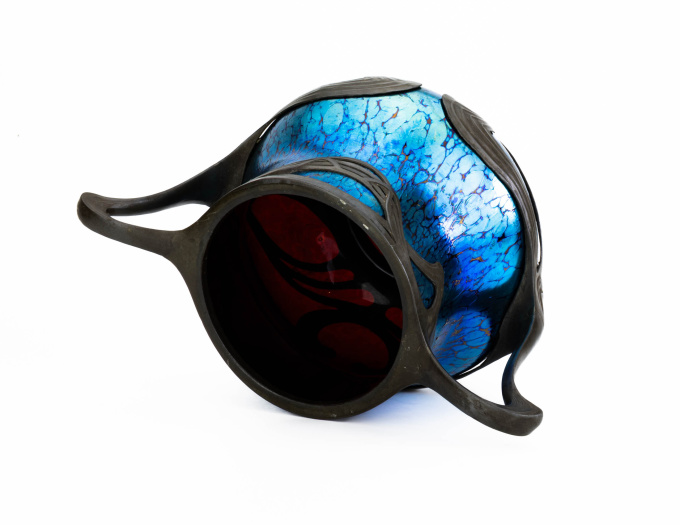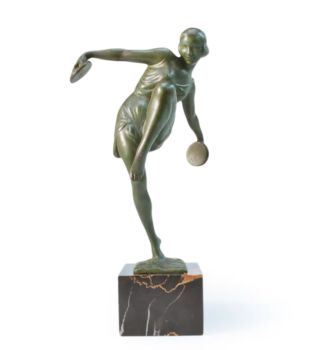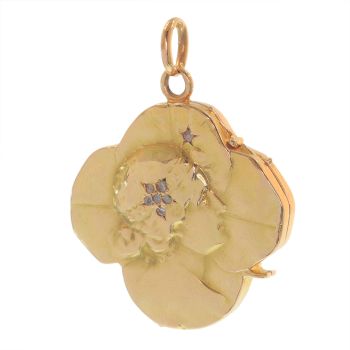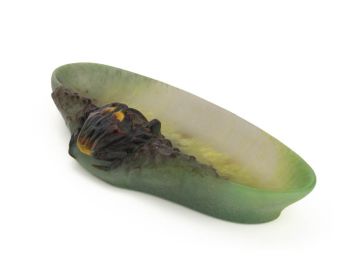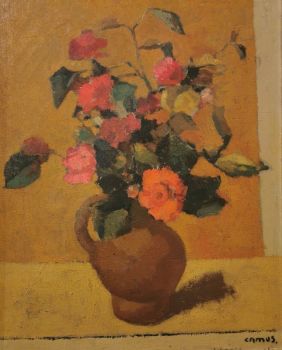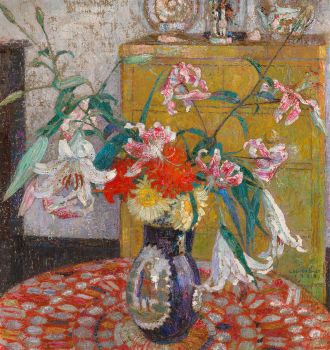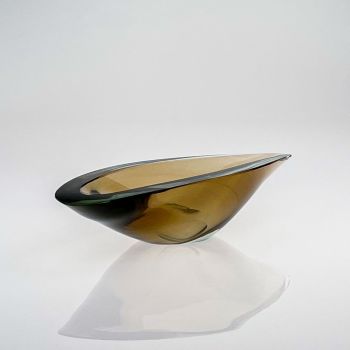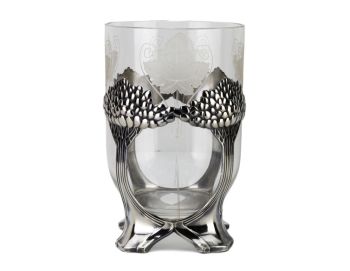Johann Loetz Witwe – Boudon & Klähr, Paris, 1900 – Ruby Papillon – Art Nouveau mount 1900 - 1909
Johann Loetz (Lötz) Witwe Klostermühle
Bicchiere
17 ⨯ 13 cm
ConditionMint
Prezzo su richiesta
Antiques Emporium
- A proposito di opere d'arteThis vase is our second mounted vase from Boudon & Klähr in Paris. This vase or bowl was created in the heyday of Art Nouveau around 1900 – 1905 through a collaboration between Johann Loetz Witwe from Austrian Bohemia and Boudon & Klähr from Paris. This creation is a perfect marriage of Austrian Jugendstil and French Art Nouveau.
The vase was blown by Johann Loetz Witwe in a ground color of ruby red glass and is executed in the decor “Papillon”. This decor made its appearance in the year 1898 and is one of the most famous, successful and probably also one of the most applied decors by Johann Loetz Witwe. Papillon is characterized by iridescent dots that change color depending on which ground color the vase is blown (Crete, Candia, Cobalt or Ruby).
Boudon & Klähr which was based in Paris represented Johann Loetz Witwe’s glass in the French capital. This vase that was sold exclusively by Boudon & Klähr, therefore, is an excellent representation of Austrian Art Nouveau glass combined with a pewter mount in French Art Nouveau design.
The literature indicates that the glass for this vase was commission-ordered from Johann Loetz Witwe by Boudon & Klähr; it is unknown by which firm the pewter frame was applied to the commission-ordered vases. In some cases Gustav Gurschner is attributed as the designer, although no incontrovertible evidence for this has been found.
Dimensions:
Height: 175mm / 6.89”
Diameter top: 130mm / 5.12″
Width mount: 265mm / 10.43″
Literature:
Prestel – Böhmisch Glas 1880 – 1940 Band 1 Werkmonographie. Page 98 & 99. - A proposito di opere artista
La vetreria Loetz esisteva a Klostermuhle, in Austria, da poco più di cento anni, a partire dal 1840. Ma il suo periodo di massimo splendore fu durante la vita di Max Ritter Von Spaun, nipote dell'originale Johann Loetz che aveva fondato l'azienda.
Von Spaun rilevò l'azienda nel 1879 e la diresse fino al 1908, un anno prima della sua morte. Fu assistito da Eduard Prochaska, suo tecnico specialista, e insieme inventarono, progettarono e produssero tutta una serie di meravigliosi nuovi tipi di vetro, ottenendo numerosi brevetti e vincendo premi in tutte le maggiori esposizioni mondiali durante gli anni 1890 e i primi anni del il nuovo secolo.
L'azienda Loetz era tra i leader nel design Art Nouveau e in particolare nel vetro artistico iridescente. Il vetro "Papillon", come il vaso a sinistra, è talvolta noto oggi come vetro "macchia d'olio". Un'altra colorazione preferita di Loetz era il vetro irridizzato con scie tirate chiamato vetro "Fenomeno".
C'erano vasi irrigiati con nastri di colori metallici che si snodavano sulla superficie, e molti disegni spettacolari con scie applicate di bellissimi colori, o semplicemente tirati fuori dal corpo del vetro per formare maniglie o decorazioni.
Intorno al 1900 l'azienda iniziò a collaborare con designer esterni e alcuni grandi artisti disegnarono pezzi per Lotz, in particolare Joseph Hofmann, Koloman Moser, Maria Kirchner e Hofstatter.
Nel 1908 Loetz fu rilevata dal figlio di Max Von Spaun, anche lui chiamato Max, e sebbene stentasse finanziariamente (fallendo nel 1911 e di nuovo nel 1931) ci furono diversi grandi designer il cui lavoro fu prodotto da Loetz in quegli anni e attraverso l'arte periodo déco. Questi includevano Adolf Beckert e Michael Powolny.
Sei interessato ad acquistare questa opera d'arte?
Artwork details
Related artworks
Johann Loetz (Lötz) Witwe Klostermühle
Johann Loetz Witwe - Phänomen Genre 7773 – Orange1900 - 1910
Precio a consultarAntiques Emporium
Johann Loetz (Lötz) Witwe Klostermühle
Johann Loetz Witwe – Jugendstil Cobalt Papillon vaas1900 - 1910
Precio a consultarAntiques Emporium
Johann Loetz (Lötz) Witwe Klostermühle
Johann Loetz Witwe – Ausfuehrung 146 Titania vase – 19121910 - 1919
Precio a consultarAntiques Emporium
1 - 4 / 7- 1 - 4 / 24
Artista Desconocido
François-Théodore Legras – Tall “Fleurs de Pommier” apple blossoms vase1900 - 1909
Precio a consultarAntiques Emporium
Amalric Walter
Amalric Walter & Henri Bergé – Crabe plumier1920 - 1929
Precio a consultarAntiques Emporium
Johann Loetz (Lötz) Witwe Klostermühle
Johann Loetz Witwe - Phänomen Genre 7773 – Orange1900 - 1910
Precio a consultarAntiques Emporium
1 - 4 / 24Jan Sluijters
Mother with two children in bathroom1900 - 1950
Precio a consultarStudio 2000 Art Gallery
René Lalique
Un florero "Fougeres" de color verde oscuro muy raro diseñado por R. Lalique1912
€ 8.950Lennart Booij Fine Art and Rare Items
 curada por
curada porSilla Scheepens
Paulus Franciscus Kromjong
Flores frente a Arearea Aka (alegría) por Gauguin '20th century
Precio a consultarZebregs & Röell - Fine Art - Antiques
1 - 4 / 24Gabriel Argy-Rousseau
Gabriël Argy-Rousseau – Crabes et Algues vase – 19201920 - 1929
Precio a consultarAntiques Emporium
Artista Desconocido
François-Théodore Legras – Tall “Fleurs de Pommier” apple blossoms vase1900 - 1909
Precio a consultarAntiques Emporium
1 - 4 / 24Demetre Chiparus
Demetre H. Chiparus – Bronze Art Deco statue “Rapture” – Édition Etling, Paris1920 - 1929
Precio a consultarAntiques Emporium
Amalric Walter
Amalric Walter & Henri Bergé – Crabe plumier1920 - 1929
Precio a consultarAntiques Emporium
Johann Loetz (Lötz) Witwe Klostermühle
Johann Loetz Witwe - Phänomen Genre 7773 – Orange1900 - 1910
Precio a consultarAntiques Emporium
Gabriel Argy-Rousseau
Gabriël Argy-Rousseau – Crabes et Algues vase – 19201920 - 1929
Precio a consultarAntiques Emporium
Artista Desconocido
François-Théodore Legras – Tall “Fleurs de Pommier” apple blossoms vase1900 - 1909
Precio a consultarAntiques Emporium
Frères Daum
Daum Nancy – “Paysage Soleil Couchant” vase with two applied handles1900 - 1910
Precio a consultarAntiques Emporium
1 - 4 / 12












